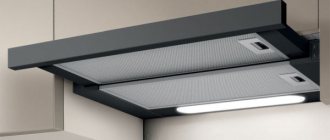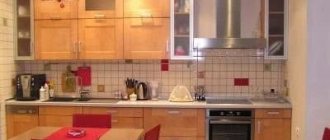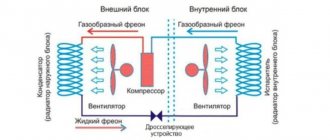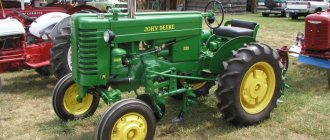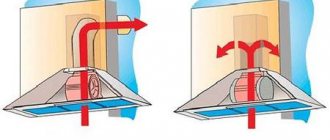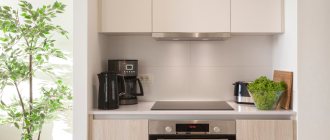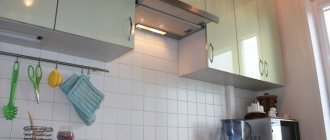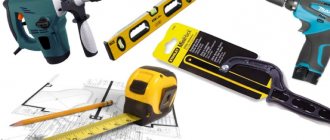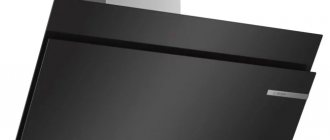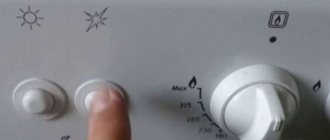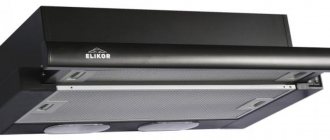What is a fireplace hood
Fireplace ventilation is a device designed to extract smoke, unpleasant odors and combustion objects emitted during the preparation of culinary masterpieces. This name is associated with its dome shape and design, which in appearance resembles a classic fireplace.
This hood includes:
- control unit for the front part of the installation;
- backlight;
- filter system;
- pipe and body.
At the same time, such a hood can be equipped with both trapping filters made of aluminum and carbon filters that absorb small contaminants and odors. The lighting system uses halogen, neon or LED lamps. Incandescent lamps are also less common, and their number will depend on the individual model.
Fireplace hood: what is it?
A fireplace hood is designed to extract smoke, unpleasant odors, and combustion products created during the cooking process. The fireplace hood got its name because of its dome shape and design similar to the exhaust system of a traditional fireplace.
She has:
- Control unit on the front of the structure;
- Backlight;
- Filters;
- Casing and pipe.
The filters used in the hood can be heat-catching - aluminum or synthetic; carbon, which capture small particles and odors. Hoods can be equipped with lighting consisting of halogen lamps, incandescent or neon lamps, LED and fluorescent lamps. The number of lamps is from 1 or more, depending on the hood model.
The principle of operation of a fireplace hood
This device operates on a simple principle, which involves drawing polluted air outside through a ventilation shaft, which can also be passed inside the room through filters.
The kitchen fireplace hood remained unchanged in its design for many years. The appearance of small improvements in the form of touch controls has become a distinctive feature of modern models.
The operating principle of a fireplace hood.
Models that vary in appearance may have a hidden discharge pipe. Thanks to this configuration, their appearance becomes more attractive. If the kitchen space occupies a large space and is combined with the living room, and the kitchen equipment is placed according to the “island” principle in the middle of the room, then the ventilation system requires the installation of island hoods. The standard placement of kitchen furniture along the walls is characterized by the use of wall-mounted exhaust systems.
The device should be selected depending on the ventilation system. A village house made of wood is rarely equipped with a ventilation shaft. In this case, ventilation is developed and installed with your own hands. The design of a complete ventilation system can be associated with the choice of a simple filter model of a kitchen fireplace hood. However, it may turn out to be ineffective, since the purified air will not be removed from the room, but will only be filtered.
Fireplace hood - design and purpose
The traditional form of a kitchen hood with a ventilation outlet is dome. It consists of a base, a trapezoidal or semicircular dome and an exhaust pipe. A dome-shaped hood is also called a fireplace hood, since in its shape it resembles home chimneys that were installed above fireplaces and hearths. This system is connected to the air duct, unlike circulation devices.
Fireplace hoods also include built-in and inclined hoods, which have a similar design. The device can be wall-mounted or island-mounted. As a rule, dome models are installed against the wall due to the proximity of the chimney and the bulkiness of the device. However, if the scale of the kitchen and communications allow, you can mount the device to the ceiling, making an island hob.
What is the purpose of a kitchen hood? It helps purify the air in the room by removing combustion products coming from the stove into the chimney. The device also removes smoke, steam and unpleasant odors. With the help of ventilation ducts, the device can not only remove dirt, but also promote the flow of fresh air. All these conditions are certainly necessary for any modern kitchen.
Air purification method
Modern hoods have two types of cleaning: exhaust and recirculation.
The exhaust involves removing air from the apartment through a ventilation duct. This method is considered more effective. However, the need to pull the air duct is very upsetting for many for aesthetic reasons.
To protect internal parts, the unit is equipped with a metal grease trap, where the bulk of the contaminants are deposited. It is removable and needs to be washed as it becomes salted.
Recirculation devices drive the air through filters and return it cleaned to the room. This technique is suitable for those homes where connection to the ventilation duct is impossible for any reason.
Also, be prepared to incur additional costs for fairly frequent replacement of parts of such equipment. There are two stages of cleaning here.
- A mesh-shaped cassette for removing large oil particles and preventing them from getting inside. After a certain level of contamination, it must be replaced with a new one.
- The carbon filter captures unpleasant odors and must be replaced approximately every 4-6 months.
The display system will remind you of the need to install or wash filters. This may be a light indicator or a message on the display, and in some budget solutions, special symbols disappear on the purifier itself as the resource is used up.
There are devices that can operate in two modes. This is especially convenient in winter, when it is unprofitable to remove warm air from the apartment.
Size
The size of the hood is not the least important, especially for installation. Keep in mind that if your cabinet is 60 cm wide, then the built-in hood will be slightly smaller to fit inside. The most standard gradations of built-in hoods are 45, 60 and 90 cm. Models of 50, 70 or 80 cm are less commonly used. You need to select the width based on the dimensions of the hob. The hood should be equal in width or larger in order to capture air above the burners as efficiently as possible.
It is also important to take into account the depth of the wall cabinet so that the hood structure does not stick out anywhere. Dome (fireplace) hoods are usually selected so as to completely cover the space above the hob.
In any case, the most important thing is to take the exact dimensions of either your kitchen unit or the space allocated for the hood, so that when you make a purchase, you don’t have to think about how to fit a 60-centimeter hood into a half-meter cabinet. An approximate understanding of the relationship between the device and the locker:
Advantages of fireplace hoods
These designs will not only become indispensable in the kitchen, but will also fit perfectly into the interior of any style. In addition, such a device will appeal to all housewives who dream of a fireplace, but are unable to purchase one.
At the moment, the following types of hood design can be distinguished:
- wall;
- hanging;
- corner;
- inclined;
- island
REFERENCE! In addition, all models have different sizes, and devices in sizes 50, 60 and 90 cm are especially popular among consumers.
At the same time, fireplace hoods have many advantages, and the main ones include the following.
- Appearance. These designs have a beautiful and stylish design.
- Dome shape. Such hoods do not require special masking in the ventilation pipe during installation. It will hide all the details that you don’t need to see.
- Efficiency at work. Regardless of the size and model purchased, the fireplace hood will delight you with a high level of performance. Some models even have two built-in motors and reusable filters.
- Easy installation. For installation it is not at all necessary to have experience or any knowledge. Each user can install it independently using dowels and screws.
- Affordable price. Of course, the cost of the design will depend on the specific brand, functionality and size of the device, but in any case, the price range is simply huge, and the consumer will be able to choose the right option for themselves, based on personal preferences.
Fireplace hood
It doesn’t matter whether your kitchen is small or large, while cooking, particles of soot and grease settle on the surface of the walls and furniture. The fireplace kitchen hood does an excellent job of removing combustion products. This device is available on the market in a variety of colors, shapes and sizes.
The fireplace hood operates in air exhaust and circulation . It is called a fireplace because of its dome-shaped shape, as well as its design, which is similar to a traditional fireplace system. The appearance of such an exhaust device is very representative and aesthetic.
Features of fireplace hoods
The most common option is a wall hood. It got its name because of the wall mount above the stove. The large area of this design cleans the air well, even if a large hob is installed in the kitchen.
There are also inclined fireplace hoods. In such models, the air intake is at an angle, which solves the problem of hitting your head on protruding parts. They are easy to use, but are more expensive than others.
The island hood is installed on the ceiling and is available in many models. Operates on an electronic control system.
The most expensive are corner models. Their range is limited, but they have many different functions: they determine the degree of air pollution and are equipped with sensors that start working when a person approaches.
Other characteristics important for selection
Other characteristics that may be important when choosing a hood are backlighting, number of speeds, timer, presence of a display, type of control, etc.
It is very convenient if the equipment is equipped with lighting - this will allow you to control the cooking process and not miss the moment of burning.
The presence of several speeds allows you to adjust the intensity of the hood depending on air pollution. The timer allows you to automatically turn off equipment at a specified time. The choice of control type is determined by ease of use: some prefer a touch option, others prefer a push-button, lever or rotary control mechanism.
Selection rules
Buying a fireplace hood is no different from choosing other models of kitchen appliances. The same requirements must be met here:
- The width of the air intake is no less than the hob. Usually this is 60 cm, but you can find compact models of 50 or even 40 cm if you have a small stove with 2-3 burners. There are also huge hoods on sale with a socket of 80-100 cm for professional stoves with 6-8 burners.
- Exhaust power – it must be sufficient to effectively clean the entire volume of air in the room. To calculate it, you need to multiply the cubic capacity of the kitchen (or combined space) by a factor of 12. The resulting figure is the minimum acceptable performance for your equipment. Add another 10% to it and you can safely choose a model based on this parameter without overpaying for excess power.
- Control type. For the simplest and relatively inexpensive hoods, a simple push-button or slider mechanism will suffice. But if you need a truly functional model, it makes sense to fork out for equipment with a touch panel or with a remote control.
- Noise performance is not an unimportant factor, especially if the kitchen is combined with the living space of a studio apartment. The quieter the better here. But only expensive imported hoods are capable of truly quiet operation without power limitation. The average figure at approximately the second stage is 40 dB, and when switching to turbo mode, the noise level can increase to 60-70 dB. If you want to find something quieter, look for models with two fans.
- Additional functions. Even the cheapest designs have backlighting, and options like a timer or automatic on/off can be chosen solely for reasons of your own convenience. But remember that every extra function increases the cost of the equipment.
Installation of a fireplace hood
Devices such as Eleyus Solo Country 1000 LED SMD 60 N BL, Gorenje WHI621E1XGW and others are distinguished by their ease of installation. But before attaching fireplace hoods, a number of points are taken into account, and the following actions are carried out:
- the location area is determined;
- guidelines are drawn for subsequent installation;
- distance measurements are taken;
- the possibility of connecting the pipe to the ventilation duct is established;
- The mounting location itself is determined using pencils and installation is carried out.
For installation in all cases, as a rule, screws or dowel-nails are used. The fireplace wall hood is mounted like other types of this equipment. Initially, holes are drilled, fasteners are inserted, and then the device is mounted. Afterwards, you need to check the quality of the fixation so that the hood is securely attached to the wall. Installation work is not complicated, which ensures convenience for the user.
Useful to know : “How to clean a hood? How to clean a hood filter – 5 important aspects.” The main thing is to follow the prescribed actions and take into account the features. These are: 1. The indicator for the location of the hood above an electric stove is 0.5 m. Above gas hobs, you need to hang a fireplace-type hood at a height of 0.6 m. 2. The device must not be located in the opening area of wall cabinets of kitchen furniture. Consequently, the technical parameters are set in advance, based on already installed headsets. 3. For rooms where cooking is carried out frequently, complex cleaning is required, so the hood must have a motor, which is distinguished by its impressive dimensions and power. 4. Models with a width of 50 cm or less are installed only above small cooking surfaces. 5. The installation of all types of fireplace hoods is the same and does not differ in any special features. In the case of autonomous variations, it is enough to provide access to the electrical network, make holes and install the device using fasteners. If you purchase a hood with air exhaust, then a ventilation structure is also required. 6. Leave free space between the pipe and the ceiling to avoid vibrations. This guarantees the quality of the hood.
It will be useful to read “Why is the hood very noisy? 3 most common situations."
Installation of a kitchen fireplace hood
Read the instructions. Where it is described how to install a fireplace hood. A good manufacturer posts an electronic version of the document on the website and provides the required installation dimensions inside. It happens that when you buy equipment, you understand: it won’t work in your house, you can’t install the product correctly. Inventing is the last thing. Official instructions are needed. Life example:
- the inclined hood LC958WA60 is suspended at a height of 55 (65) cm when measured from the middle of the portal, depending on whether the stove is electric or gas;
- the above-mentioned White Storm 60 gold antique, according to the instructions, is suspended 10 cm higher in each case, the portal is horizontal.
Nuances are a dime a dozen. If you hang kitchen fireplace hoods low, they will burn; if you hang them high, they won’t catch grease, the air will scatter throughout the room, covering the walls and ceiling with soot. Depth matters. The portal should completely cover the hob area. The installation of the fireplace hood is carried out strictly according to the instructions. Fire safety and hygiene standards are required.
The installation kit of the equipment in question is not as complex as a built-in washing machine; there are some interesting details. Fireplace hoods have corrugated outlets; an adapter is supplied that makes it possible to connect to the next standard size. The total is, for example, 125 and 150 mm. It is difficult to connect a standard air duct. There is one for 125 mm.
The fireplace hood is installed using dowels and nails; the supplied screws are flimsy for concrete. The riser often passes, touching the width of the slab; boards are first placed on the dowel-nails, and the hood is attached on top with flimsy screws. It terribly disfigures the picture, nothing better could have been invented. Should I call the gas service: the hob has been moved.
There are no problems with electric models. Considered the best (just kidding). Today, convection cabinets with forced airflow are leading the sales. Often something like a halogen air fryer lamp is used. The design is considered optimal and gives the cook an unimaginable field for creative activity. The family will appreciate it!
Division of fireplace hoods according to air purification method
The method of air purification involves dividing fireplace hoods into the following types:
- Flow-through.
- Circulating.
Stages of cleaning a kitchen hood filter.
If the fireplace model operates in circulation mode, then the contaminated air can pass through a series of filters, after which it is returned to the kitchen area. With this method, the equipment is not connected to the ventilation pipe. However, it is quite difficult to obtain maximum efficiency from the operation of the device.
Using the flow-through method of purifying exhaust air involves removing it completely from the room. This mode is more efficient because it provides cleaner air in the kitchen. In this case, it will be necessary to carry out work related to the installation of the hood when connecting it to the ventilation shaft.
Any type of kitchen hood has filters that can be disposable or reusable. The former require timely replacement, while the latter should be removed once a month to remove dirt and grease. Flow hoods have a motor that can wear out prematurely. Because grease sticks to it, the fan blades must be protected. Each dome hood is equipped with coarse grease filters. If a carbon filter is installed, it must be changed once every 4 to 6 months.
If filters are not replaced in a timely manner, the quality of air purification deteriorates.
Fireplace hood for the kitchen
An exhaust system is an integral element of any modern kitchen. It helps prevent the occurrence of unpleasant odors and the formation of grease deposits on supporting structures, furniture, and ceilings. Fireplace models are in fashion today. What does a fireplace hood mean for a kitchen? What are its advantages? What should you consider when purchasing?
Installation of a fireplace hood
When installing a fireplace hood, you need to decide on the design, since there are three main options.
This:
- Wall hoods, which are mounted to the wall above the main equipment that pollutes the air.
- Island hoods, which can be located in the center of the room, above the equipment.
- Corner hoods are located in the corner of the room. Such hoods are an excellent choice in a small kitchen area.
The main thing when installing a hood is its positioning, that is, the minimum distance between the highest part of the device and the lowest when preparing food. If the stove is gas, then a distance of at least 65 cm must be maintained between it and the hood.
Electrical connection and installation of the hood must be carried out by qualified personnel of the store where the purchase was made in order to comply with the warranty and return if there is a defect.
If you install the hood yourself, then if it breaks, it will be impossible to return it to the store.
When using an exhaust hood, you must turn it on a minute before starting food preparation, this is done in order to create the correct air flow to direct combustion products and steam to the suction surface. When cooking is completed, the hood must be left on for 15-20 minutes, until all odors and combustion products are completely aspirated.
All hoods have filters that need to be replaced or washed.:
- Metal filters are washed every 30 hours of operation. They need to be soaked in hot water and dishwashing detergent.
- Optional filters are replaced after 4 months.
- Activated carbon filters must be washed in the dishwasher after 4 months of use.
The outer surface of the hood must be cleaned every two weeks, but please note that abrasive detergents should not be used to avoid damaging the surface.
Fireplace hood
Fireplace ventilation is a dome-type hood . It got its name for its resemblance to the air duct element of a classic fireplace. Today, fireplace hoods have become especially popular, because with their help you can not only clean the air from combustion products and food odors, but also create a cozy kitchen interior. Devices of this type are corner, wall, island and inclined. A wide selection of these designs allows you to place them in kitchens with any design lines from classic to modern and high-tech style. Dome structures have a lot of advantages and do an excellent job of cleaning the air.
Advantages of dome ventilation
Dome hoods are a classic option for kitchen ventilation. They owe their popularity to undeniable advantages over other devices, namely:
- Universal design . Domes do not need to be masked or built into furniture; they fit perfectly into any interior, adding sophistication and comfort.
- High performance . Fireplace hoods for kitchens belong to the class of flow-through ventilation systems; they have high power and performance.
- Easy to install. Installation of a dome vent does not require any special knowledge or skills. You can install it yourself by following the instructions.
- Affordable price. A wide variety of models allows you to choose a dome in any price category, which makes it accessible to almost all consumer groups.
Installing a fireplace hood for the kitchen
A hood is a guarantee of comfortable work in your kitchen. Natural ventilation will never be enough, especially during the heat of summer or the cold of winter. Therefore, people began to resort to installing this artificial type of air purification, which is filtered through the ventilation duct.
The heat generated from cooking is immediately eliminated and does not bring the discomfort that is guaranteed to be present in kitchens with natural ventilation. Plus, kitchen hoods ensure the cleanliness of the room - the walls will not smoke, the ceiling above the stove will not darken. With this device there will be no complaints about foreign odors or other problems.
A fireplace hood is an ideal choice for those who love quality and sophistication
Brick and terracotta are certain types of clay, the only difference is in their production. Fireplace-type hoods have a major advantage, unlike standard options. It's all about the appearance, which gives the impression of real prestige. This is a really expensive building that not everyone can afford, but the impressions from its presence are truly mesmerizing.
The best fireplace hood for the kitchen: differences
A fireplace hood has a number of advantages, which include matching the style of the interior, hygiene and cleanliness in the room, and the absence of smoke from walls and furniture. Before choosing a fireplace hood, we determine the type of installation: wall-mounted fireplace, corner fireplace, island fireplace and its mode of operation, either air exhaust to the outside of the room or circulation. Fireplace hoods are made by many manufacturers: Falmec, Maunfeld, Vialona, Kuppersberg, Anton Bauer, APC, Exiteq, Electrolux, ILVE, Siemens, Samsung, Zanussi, Bosch, Best and many others.
Let's look at several models of fireplace hoods:
- Kitchen hood, fireplace type, manufactured by Bosch, model DWW 07W850. This model has a wall installation with a built-in width of up to 70 centimeters and a productivity of 760 cubic meters per hour. The device combines two operating modes: air circulation and air removal (forced). Halogen lamps. The advantages of this device: build quality, easy control, as it is done half mechanically, filters are easy to remove and wash, the surface of the hood is made of a stainless alloy. The disadvantages are the lack of an indicator that shows filter contamination, average noise level (71 dB).
- Siemens LF 91BA582 fireplace kitchen hood, island. It has a capacity of 710 cubic meters per hour and a built-in width of 90 centimeters. Combines two types of mode: circulation and exhaust. The advantages of this device are its quiet operation (63 dB), the presence of a filter contamination indicator, the presence of a timer and touch controls. The downside of this device is its high cost (from 80 thousand rubles).
Many hoods are equipped with a noise reduction system, which will reduce the risk of discomfort during operation, but their cost will be sharply inflated
The cheapest hood can be purchased for an average of 2 thousand rubles or more, the difference will be in its performance, which will directly affect the air quality in the room. The greater the productivity, the better the air will be cleaned.
The presence of a remote control, as well as a sensor on the panel, a timer can increase the cost of the exhaust device, and therefore, when choosing, you need to pay attention to the performance and noise level, which vary greatly.
The noise produced when the hood is operating can cause discomfort. The most optimal numbers on the noise scale of kitchen appliances are from 5 dB to 60 dB. At 65 dB and 70 dB, it can be compared to loud talking, screaming and laughing. Accordingly, equipment that operates within these limits will be clearly audible.
What criteria to consider when choosing a fireplace hood
Most consumers are confident that a large hood will be an excellent choice for any kitchen because it has more power. But fireplace models are not suitable for installation in large areas. But they will be an ideal option for installation in small kitchens, because they have compact dimensions and allow you to save space for placing a variety of cabinets, drawers or shelves.
Power
In order to make sure that a particular model has sufficient power, you will need to use a basic mathematical formula, namely, calculate the area of the kitchen, and then multiply the resulting figure by 12. You don’t have to do the calculation at all, but find out the necessary information from a consultant in a household appliance store . According to established standards, consumers are recommended to install models with a power rating of 350 cubic meters. m for small rooms (no more than 11 sq. m). In medium kitchens (11–18 sq. m.), you need to install a model with a capacity of up to 420 cubic meters, while in large kitchens (20 or more sq. m.) you should install structures with a capacity ranging from 600 to 650 cubic meters.
Noise during operation
It should be understood that the higher the power of the purchased model, the louder it will work. And you must admit, you are unlikely to enjoy cooking under the constant hum of the device, which does not even allow you to hear the voice of other household members.
IMPORTANT! It is necessary to select models whose operating noise level can be adjusted using a special switch.
Filter system type
Most hoods differ in the type of filter. Kitchen appliances are supplied with:
- external filter – to retain fat and soot;
- internal - to clean the air from unpleasant odors.
In more expensive models you can also find grease-repellent filters that practically do not need cleaning . In devices representing the budget category, filters become dirty after just a few months of operation, and cleaning them is fraught with a number of difficulties.
IMPORTANT! If you notice that during operation of the hood, the air is not cleaned for an impressive period of time, this means that the filter is very dirty and needs to be urgently replaced.
Material of manufacture
Another selection criterion will be the material of the device. The stronger it is, the longer the installed structure will last. For the manufacture of fireplace hoods, metal is used, which is highly reliable. But sometimes there are also models made from plastic, glass and even wood.
In any case, which model to choose will depend solely on you, but the information presented above should greatly simplify the selection process.
How to choose a model
Many people believe that a large hood is much better, since it has more power. If a fireplace hood is needed for a spacious kitchen-dining room, then this option will be appropriate.
For a standard kitchen, a small hood -50.60 cm is suitable. Its power will be more than enough, and its small dimensions will perfectly save kitchen space for additional shelves or drawers.
Customer Reviews
Have you read a bunch of articles on the topic “how to choose a fireplace hood for your kitchen”, looked through dozens of photos on the Internet, but still don’t know what to buy in the end? Reviews. This is what will really help you.
If you follow the positive example of other people, the likelihood of making a mistake will be reduced to a minimum. The most popular, based on reviews, is the Krona fireplace hood. This model has an impeccable appearance and stylish design, since all its panels are smooth, even and white.
Despite its high performance, it is completely silent during operation. You can select the operating mode of the hood by lightly touching the special panel. The grease filter can be easily removed and washed.
This model will easily fit into any interior and will protect furniture and walls from odors and grease.
Ventilation for the fireplace room
The design of a modern apartment can be a real work of art. You can often find real fireplaces in homes today. Of course, you cannot install a wood-burning fireplace in an apartment, but electric fireplaces can become a real decoration of the living room. For gas and electric fireplaces, you can also use a dome hood. A fireplace hood will complement the composition and allow you to create a reliable imitation of a real fireplace. However, you need to remember that if an air duct is not needed for electrical appliances, then for a gas fireplace the ventilation must be connected to the air duct pipe, because gas combustion products are hazardous to health.
